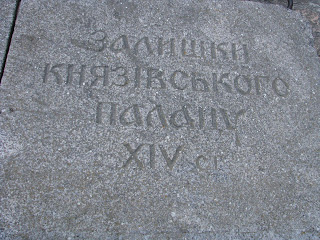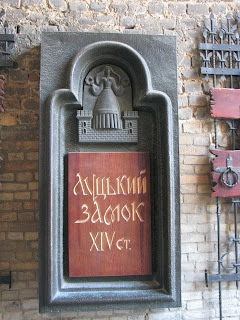Lutsk is one of the most ancient Ukrainian towns. The name "Lutsk" was first met within the Ipatient Chronicle of 1085. At that time Lutsk became the center of the civil was between the heirs of Yaroslav the Wise the prince of Kyiv Rus.
However, archeological research gives suffient grounds to believe that the settlement was founded in about 1000 A.D.
The most trustworthy version of the origin of the name Lutsk (ancient Luchesk) is related to the geographical position of the town at the bend (luka) of the river Styr. It should be mentioned that the settlement appeared on the island formed by the Styr and its tributaries.
Lutsk witnessed the Tatar-Mongol invasion. The chronicles state that in 1259 the town was under the siege of khan Kuremsa. Prince Vasylko destroyed fortifications in 1261 on demand of Buronday, the khan's commander.
Achievement of a more significant role of Lutsk as the capital of Volyn lands is closely connected with the rule of Lubart-Dimitriy in the second half of the 14th century. It was he who changed the look of town fortifications having replaced the wooden constructions by the brick ones.
The son of the great Lithuanian duke Gedymir, Lubart was a real protector of Volyn. He was married to the local princess and adopted the Orthodox religion. Under his rule Lutsk Castle was the seat of administrative, court and church bodies that governed Volyn.
After Lubart's death Lutsk remained the residence of Lithuanian and Russian princes: Vitovt (1392-1430), Svydrygaylo (1431-1452). Under Vitovt's rule Lutsk housed the famous meeting of European monarch, the main participants being the great Lithuanian duke, the king of Poland Vladyslav II Yagaylo and the emperor Sygizmund of Luxemburg.
Magdeburg right granting was an important moment in the sociapolitical and economic life of Lutsk town dwellers in the 15th century.
Beginning from the late 16th century the Lutsk castle lost its significance as the defense stronghold. Nevertheless, the town remained worldly and spiriual capital of the region.
After the Lublin Union in 1569 Volyn was intrgrated into the Kingdom of Poland and Lutsk became the capital og a new formed "voyevodstvo" and the residence of Polish local rules called voyevodas.
Late 17th-18-th centuries is the period of Lutsk slow decay. Frequent fires, floods and epidemics were devastating it. Cultural and religion life was gradually coming to a standstill.
In 1795 after the third division of Poland the region and its capital were joined tj the territory of the Russian Empire. The capital of the newly created Volyn province was Zhytomyr and Lutsk had the status of the "povit center".
The 19th century did not lead to the revival of economic and social life in the town. Lutsk economic rise began with the construction of a South-Eastern railroad branch in 1890's. At that period Lutsk had the population of 15 125 inhabitants.
During the World War I Lutsk was the battlefield of fierce combats. In summer 1915 a famous Brusylivsky Breakthrough took place in Lutsk suburbs. This event left its trace in the history of the World War I.
After the February Revolution in 1917 a blue and yellow flag was hoisted adove the town for the first time. In April 1917 the first Ukrainian socio-cultural society named "Ukrainian Community" appeared in Lutsk/
On May 16, 1919 Lutsk was occupied by the Polish army according to the Riga Treaty of 1920 Western Volyn got into territory of Polish State Rich Pospolita. In March 1921 Lutsk became the capital of tne new Volyn voevodstvo.
On June 25, 1941 the World War II came to Lutsk the town was occupied by German troops.
In the afret-ar time period Lutsk was rebuild and renewed step by step. The greatest development was achieved in the 60's-70's of the 20th century. In 1973 the borders of a new town territory were fixed and at present time the territory of Lutsk equals 4 167 hectares/ At that period the construction of such powerful enterprises as: a ball-bearing plant, a fabrics factory and other industrial centers was also started. This resulted in the rapid increase of population.
Nowadays Lutsk is still among the leaders in political, economical, cultural and religious life of Volyn. This town is one of the largest in the Western Ukraine (about 206 000 inhabitants).
Volyn Region is the north-western border of Ukraine. Such favourable gegraphical position makes Lutsk the center of international trade. New economic conditions of evelopment change the appearance of the town.
The main place in Lutsk is Teatralna Square. Here you can see and hear many concerts, exhibitions and other measures. This is the main place of youth's meetings. Theere is the Volyn Academic Musical-Dramatic Theatre by T.Shevtschenko here. There is Lesja Ukrainka monument in front of this theatre.
There is the Lutsk's Palac of Culture on the left hand of the theatre.
There is the Saint Troizkiy Cathedral in front of the theatre.
Many streets begin from Teatralna Square: Vynnichenka, Lesi Ukrainky, Voly avenue. Lesi Ukrainky street is foot-street.There are many interesting and old buildings.
There is the Council of Lutsk not far from here.
You can see the Saint Nikolay monument in front of the Council of Lutsk. Saint Nikolay is the city's patron.
There is the Puppet-house on the left hand of the Council of Lutsk.
At the end of Lesja Ukrainka strert you can see the former house of owners Kronshtein. Nowadays this is the Medical college.
Here you can see the Square Bratskiy bridge. But you cannot see the present bridge only the square.
On the left hand of this place you can see Danylo Galytskiy street. This is the quiet street with many sights.
Polish Roman-Catholic church St. Peter and Paulo.
The main adornment of Lutsk is Lutsk Castle. Here you can walk during many hours.
After admiring Lutsk Castle you can continue to eximane the Old City. Let's go along Kafedralna street/ Here you can see the house of Kosachiv.
In front of you can see the Lutheran church.
Near this place you can find even one Castle. This castle the inhabitants name the House with chimeras/ This unusual house is creating by the local sculptor Nikolay Holovan.

















































































Комментариев нет:
Отправить комментарий